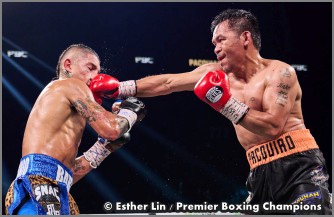
|
Philippines, 26 Dec 2025 |
Home >> News |
 |
||||
|
|
|
|
Manny Pacquiao vs. Logic By Mark F. Villanueva PhilBoxing.com Sun, 20 Jul 2025  Dateline: Paradise, Nevada – July 19, 2025. Logic tumbles in front of a roaring crowd that witnessed Manny Pacquiao back in the ring for the first time since his last professional fight on August 21, 2021. At the age of forty-six, the squared circle is the last place he’s expected to belong. The oldest fighter to win a world title is Bernard Hopkins (49), who took away the WBA (Super) and IBA light heavyweight titles by defeating Beibut Shumenov. Next is George Foreman (45), who won the WBA and IBF heavyweight titles by knocking out Michael Moorer back on November 5, 1994. At the age of forty-six, Manny Pacquiao is older than a fifty-year-old heavy. Pacquiao easily won the first round with hints of aggression, which is what boxers who don’t expect to perform just as well in the championship rounds do. They aim to end the fight as soon as possible. But Mario Barrios took control in the following rounds by staying composed—something he excels at. A skilled jabber, he wasted no time putting his reach to good use. He didn’t take any time at all to use this yardstick efficiently, and often, he would only use his right hand straight when he was sure to land it. He did so coming off pivots, as if to signal to Manny that he’s not lost in the maze of footwork. Barrios was never rattled. He never allowed himself to be drawn into an exchange longer than necessary, which could tip his natural advantages. He fought tall, from a distance, wisely. Apart from Pacquiao and his team, nobody knew his aggression was tailored to last all the way to the twelfth round. The crowd felt this, but it was only more of a belief of what he’s capable of, grounded on history, than a certainty. A thirty-three-year-old welterweight boxer is older than a forty-year-old heavyweight in boxing terms, and they do not train the same way. Fighters in the lighter divisions rely on speed and agility, firing on all cylinders, often throwing between seven hundred to a thousand punches in a fight, while their bigger counterparts invest in timing and power. They throw considerably fewer punches and do not move as much around the ring. At the age of forty-six, the “Pacman” defied logic by throwing and landing more power punches than Barrios, who is more than a decade younger. In a sense, his physical performance was more astonishing than Foreman’s or Hopkins's, except for one thing: he didn’t win the fight. Still, Pacquiao began to take over in the middle rounds—the very rounds that often shape the judges’ opinions and leave a lasting impression on viewers. Pacquiao subconsciously weaved his name back into the conversation among boxing fans. He seemed content with the Majority Decision, knowing it is enough to prove that he still has what it takes, and he did win from that draw, by opening up the possibility of a rematch, future matches in a slightly lower echelon than the likes of Terence Crawford, enough to prolong his boxing career; bigger purses, take-home more pay, and hold better bargaining chips at the negotiating table. It didn’t make sense to bet on Manny Pacquiao, the numbers, the age factor, and overall logic said no. At forty-six, he is too old for a boxer to seriously compete in any weight division. After an absence of close to four years, there seemed almost no chance that he could come out and fight as brilliantly as he did. So brilliantly, he made numbers lie. Click here to view a list of other articles written by Mark F. Villanueva. |
|
|
PhilBoxing.com has been created to support every aspiring Filipino boxer and the Philippine boxing scene in general. Please send comments to feedback@philboxing.com |
PRIVATE POLICY | LEGAL DISCLAIMER
developed and maintained by dong secuya © 2025 philboxing.com. |